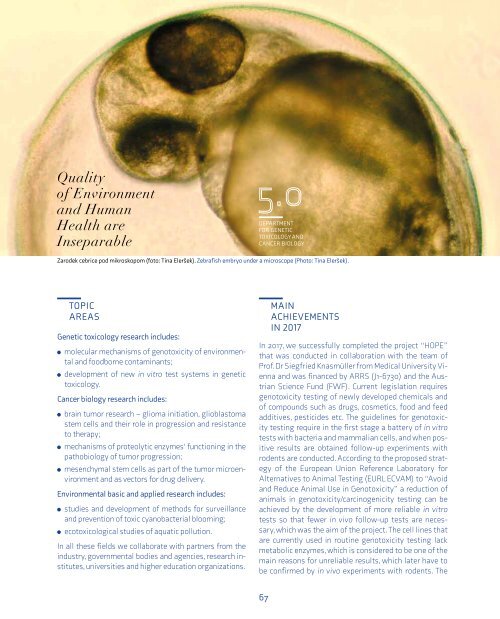You also want an ePaper? Increase the reach of your titles
YUMPU automatically turns print PDFs into web optimized ePapers that Google loves.
Quality<br />
of Environment<br />
and Human<br />
Health are<br />
Inseparable<br />
Department<br />
for Genetic<br />
Toxicology and<br />
Cancer Biology<br />
Zarodek cebrice pod mikroskopom (foto: Tina Eleršek). Zebrafish embryo under a microscope (Photo: Tina Eleršek).<br />
Topic<br />
Areas<br />
Genetic toxicology research includes:<br />
molecular mechanisms of genotoxicity of environmental<br />
and foodborne contaminants;<br />
development of new in vitro test systems in genetic<br />
toxicology.<br />
Cancer biology research includes:<br />
brain tumor research – glioma initiation, glioblastoma<br />
stem cells and their role in progression and resistance<br />
to therapy;<br />
mechanisms of proteolytic enzymes‘ functioning in the<br />
pathobiology of tumor progression;<br />
mesenchymal stem cells as part of the tumor microenvironment<br />
and as vectors for drug delivery.<br />
Environmental basic and applied research includes:<br />
studies and development of methods for surveillance<br />
and prevention of toxic cyanobacterial blooming;<br />
ecotoxicological studies of aquatic pollution.<br />
In all these fields we collaborate with partners from the<br />
industry, governmental bodies and agencies, research institutes,<br />
universities and higher education organizations.<br />
Main<br />
Achievements<br />
in <strong>2017</strong><br />
In <strong>2017</strong>, we successfully completed the project “HOPE”<br />
that was conducted in collaboration with the team of<br />
Prof. Dr Siegfried Knasmüller from Medical University Vienna<br />
and was financed by ARRS (J1-6730) and the Austrian<br />
Science Fund (FWF). Current legislation requires<br />
genotoxicity testing of newly developed chemicals and<br />
of compounds such as drugs, cosmetics, food and feed<br />
additives, pesticides etc. The guidelines for genotoxicity<br />
testing require in the first stage a battery of in vitro<br />
tests with bacteria and mammalian cells, and when positive<br />
results are obtained follow-up experiments with<br />
rodents are conducted. According to the proposed strategy<br />
of the European Union Reference Laboratory for<br />
Alternatives to Animal Testing (EURL ECVAM) to “Avoid<br />
and Reduce Animal Use in Genotoxicity” a reduction of<br />
animals in genotoxicity/carcinogenicity testing can be<br />
achieved by the development of more reliable in vitro<br />
tests so that fewer in vivo follow-up tests are necessary,<br />
which was the aim of the project. The cell lines that<br />
are currently used in routine genotoxicity testing lack<br />
metabolic enzymes, which is considered to be one of the<br />
main reasons for unreliable results, which later have to<br />
be confirmed by in vivo experiments with rodents. The<br />
67




